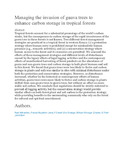| dc.contributor.author | Adhiambo, Rael | |
| dc.contributor.author | Muyekho, Francis | |
| dc.contributor.author | Creedbc, Irena F. | |
| dc.contributor.author | Enanga, Eric | |
| dc.contributor.author | Shivoga, William | |
| dc.contributor.author | Trick, Charles G. | |
| dc.contributor.author | Obiri, John | |
| dc.date.accessioned | 2021-07-09T10:25:19Z | |
| dc.date.available | 2021-07-09T10:25:19Z | |
| dc.date.issued | 2019-01-15 | |
| dc.identifier.uri | https://doi.org/10.1016/j.foreco.2018.10.010 | |
| dc.identifier.uri | https://www.sciencedirect.com/science/article/abs/pii/S0378112718312623#! | |
| dc.identifier.uri | http://r-library.mmust.ac.ke/123456789/1764 | |
| dc.description.abstract | Tropical forests account for a substantial percentage of the world’s carbon stocks, but the consequences to carbon storage of the rapid invasiveness of the guava tree in these forests is not known. Two different forest management strategies are practiced in a tropical forest in western Kenya: (1) a protection strategy where human entry is prohibited except for minimalistic human presence (e.g., research activities); and (2) a conservation strategy where human access to the forest and its resources are permitted. We assessed the effects of these management strategies and different levels of disturbance caused by the legacy effects of legal logging activities and the contemporary effects of unauthorized harvesting of forest products on the abundance of guava and non-guava trees and carbon storage in both plant biomass and soil in this forest. We found that guava trees were less likely to thrive and carbon storage in plants and soils was similar in sites with minimal disturbance under both the protection and conservation strategies. However, as disturbance increased, whether by the historical or contemporary effects of human activities, guava trees were more likely to thrive and carbon storage in plants shifted from non-guava trees to guava trees, but without an effect on more stable soil carbon. We conclude that regulations should be strictly enforced to prevent all logging activity, but the conservation strategy would provide similar effects on both forest plant and soil carbon to the protection strategy, while providing benefits to the surrounding community who rely on the forest for cultural and spiritual nourishment. | en_US |
| dc.language.iso | en | en_US |
| dc.publisher | Science Direct | en_US |
| dc.subject | Managing, invasion , guava, trees, to enhance, carbon, storage, tropical, forests | en_US |
| dc.title | Managing the invasion of guava trees to enhance carbon storage in tropical forests | en_US |
| dc.type | Article | en_US |

